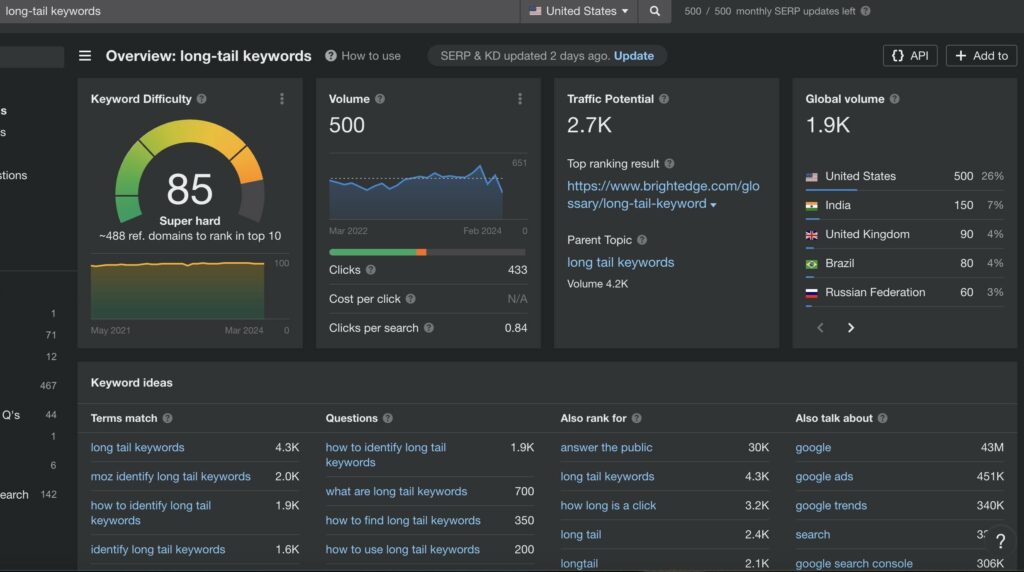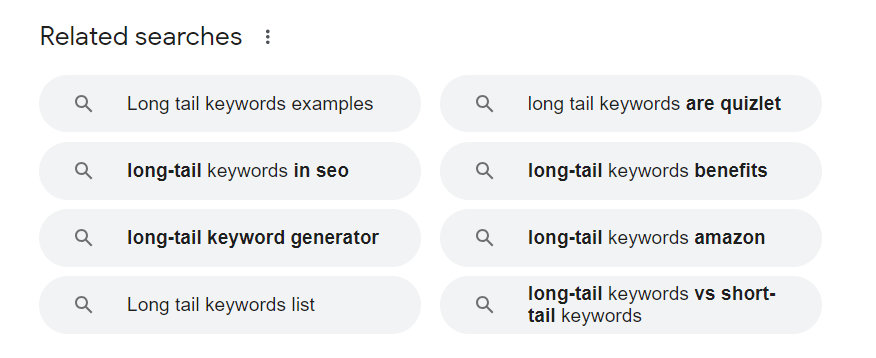
In the world of digital marketing and more specifically, SEO, the term, ‘long-tailed keywords’ has become increasingly significant. These often-overlooked keywords hold immense amounts of potential for marketers and website owners looking to improve their website’s organic traffic and online visibility. However, what exactly are long-tailed keywords, and why are they important for SEO?
Long-tail keywords – the low down
Long-tail keywords are essentially specific phrases, consisting of a few words that are highly targeted and less frequently searched compared to more generic, broader keyword terms. These keywords typically reflect user search intent and can lead to more qualified traffic, which makes them ideal for targeting niche audiences.
These keywords are often seen as valuable to SEO campaigns because they are less competitive and highly targeted, and can lead to higher conversion rates due to their specificity.
Importance of long-tail keywords in SEO
Differentiating between long-tail and short-tail keywords involves knowing their distinct characteristics and implications for SEO (search engine optimization) strategies. Short tail keywords, for example, are broad and generic terms, consisting of one or two words. Their search volume is often very high, but due to this, they face high rates of competition.
Long-tailed keywords tend to be less competitive, which makes it easier for websites to rank for them and attract relevant traffic. The key differences between the two lie in their specificity and competitiveness.
Benefits of targeting long-tail keywords
For businesses aiming to enhance their online presence and visibility whilst also attracting relevant traffic, targeting long-tail keywords may be the way to go. By focusing on specific phrases, companies can address the specific needs of their target audience.
Long-tail keywords also have significantly less competition, compared to its counterpart. This can make it easier for businesses to rank higher in the search engine results pages (SERPs) and establish their authority.
How do I find long tail keywords?
Below, we showcase certain tools that can be utilized to discover a variety of long-tail keywords.
Google Keyword Planner
Google Keyword Planner is an important tool for discovering long tail keywords, as its vast database provides extensive information such as search queries and their associated metrics. By inputting seed keywords related to your niche into Keyword Planner, it will generate a detailed list of keyword suggestions along with their search volumes and other heavily relevant data that can be utilized in future SEO strategies.
SEMrush
SEMrush helps individuals discover long-tail keywords through its powerful keyword research features. This tool provides valuable insights such as search volume, keyword difficulty and trends, aiding users to identify less competitive and more specific keyword variations.
SEMrush also offers a competitor analysis tool, allowing users to investigate what long tail keywords their competitors rank for.
Ahrefs
Ahrefs offers multiple features that can help with finding long-tail keywords effectively. There is a section named ‘Keyword Explorer’, which will allow users to input seed keywords and generate a detailed list of related long-tailed keywords. This tool is very useful for locating important data such as search volume, click-through rate and keyword difficulty.

Google search suggestions
When utilising Google’s search bar and inputting a seed keyword, this will prompt Google to suggest related search queries. These queries are based on relevant and popular searches made by users, which can make for valuable insights into potential long-tail keyword variations. Make sure to pay attention to these suggestions, as you will find specific phrases that relate to your target audience’s search intent.

Related searches
Located at the bottom of Google’s search results page, there is a section dedicated to ‘related searches’. This section is filled with additional keyword phrases related to the initial search query. Navigating through these searches can uncover additional keyword opportunities that you may not have considered initially.

How to use long-tailed keywords effectively for SEO
Including long-tail keywords in content is pretty important for optimizing SEO strategies. By carefully integrating these niche keywords into website content, businesses can increase their visibility in the SERPs. This requires on-page optimization techniques such as involving long-tail keywords in meta titles, descriptions, and headers throughout the content.
Meta titles & descriptions
Meta titles and descriptions are very important within the world of SEO, as they provide search engines with concise information on the content within the webpage. When you target long-tail keywords, make sure to add them strategically to your meta titles and descriptions.
This will not only just enhance the chances of your page appearing in the search engine results for relevant searches but also increase the possibility of gaining clicks from users who take an interest in your meta description and find it relevant to their search query.
Landing pages
Another effective strategy for leveraging long-tail keywords is to produce landing pages or blog posts tailored to these specific search queries. Landing pages should be optimized to label the intent behind the keyword, delivering valuable content that directly meets the needs of the user. Thorough keyword research is important to pick out relevant phrases with high search volume and low competition.
Balancing keyword density in order to avoid keyword stuffing is also a very important factor to bear in mind. Keyword stuffing often results in content that is difficult to read or understand, as the focus of the content is primarily to achieve a higher keyword density rather than showcasing valuable information.
Monitor & adjust your keyword strategy
This can involve regularly tracking the performance of your specific long-tail keywords and analyzing the correct and relevant SEO metrics to identify areas for improvement. Make sure to monitor key metrics such as search rankings, organic traffic and conversion rates. These will all give key insights into the effectiveness of your keyword-targeting strategy.
SEO is an ongoing process, so be prepared to iterate and modify your keyword strategy over time. Ensure you stay updated on industry trends, algorithm changes and competitor activity to change your approach accordingly.
Utilize long-tail keywords with The SEO Works
Developing expertise in utilizing long-tail keywords is crucial for boosting your website’s visibility and drawing in relevant organic traffic. However, it’s vital to keep in mind the necessity of continuously monitoring and fine-tuning your keyword strategy to stay ahead of your competitors.
By consistently refining your strategy based on performance metrics, such as data analytics and prevailing industry trends, you can make sure that your website maintains its competitive edge and achieves positive rankings in the SERPs.
Services we offer
Has this piece positively informed you about the workings behind long-tailed keywords? Why not let us showcase to you the alternate services we offer, and how together, we can achieve ranking your website in first position.
From SEO and PPC to Paid Social and Web Design, we are an award-winning digital marketing agency looking to fire your website to the top! Contact us today, we’re here to help.




